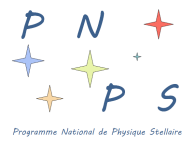By using analytical self similar solutions for magnetohydrodynamic outflows, we have modeled the magnetosphere of young, low mass, stars with a stellar jet surrounded by accretion columns and an equatorial static dead zone connecting the star to the disk. Simulations are performed with the PLUTO code on supercomputers, such as OCCIGEN on GENCI.
In parallel, we used new observations made in the collaborations from several T Tauri stars to determine the mass accretion rate in the magnetosphere and the mass loss rate in the jet, as well as estimates in those objects of the maximum of the accretion velocity and the maximum of the jet speed.
By varying the ratio of the mass accretion to mass loss rate and the size of the static dead zone, in our simulations, we have reproduced qualitatively and quantitatively the mass accretion rate, mass loss rate, accretion velocity and jet velocity we observed in several T Tauri stars, as well as values we found in the literature.
We have shown that for the range of the observed values, the presence of a sporadic magnetospheric ejection is not compulsory but depends on the ratio of mass accretion to mass loss rate, conversely to most simulations. Moreover, using analytical solutions as initial conditions allows to attain steady or quasi steady solutions within a few stellar rotations. It also shows that such solutions are remarkably stable.
More precisely, as we increase the mass accretion rate, we observe in the simulations a transition between a state where the stellar jet is separated from the accretion zone by a force-free region almost empty, with very low density, to a state where this empty region is replaced by episodic mass ejection coming from the disk and bouncing on the stellar atmosphere, creating coronal mass ejections. The threshold ratio is precisely in the observed range of ratio, i.e. for a mass accretion rate exceeding 15 to 20 times the mass loss rate. Thus, it is very likely that such a bimodal structure may be found in real T Tauri environments.
By increasing further the accretion rate, we may also explore the transition from the T Tauri to the FUOR systems. In that case we conjecture that the cylindrically collimated jet may be replaced by a conical wind, which can also be explored with the same numerical technique.



